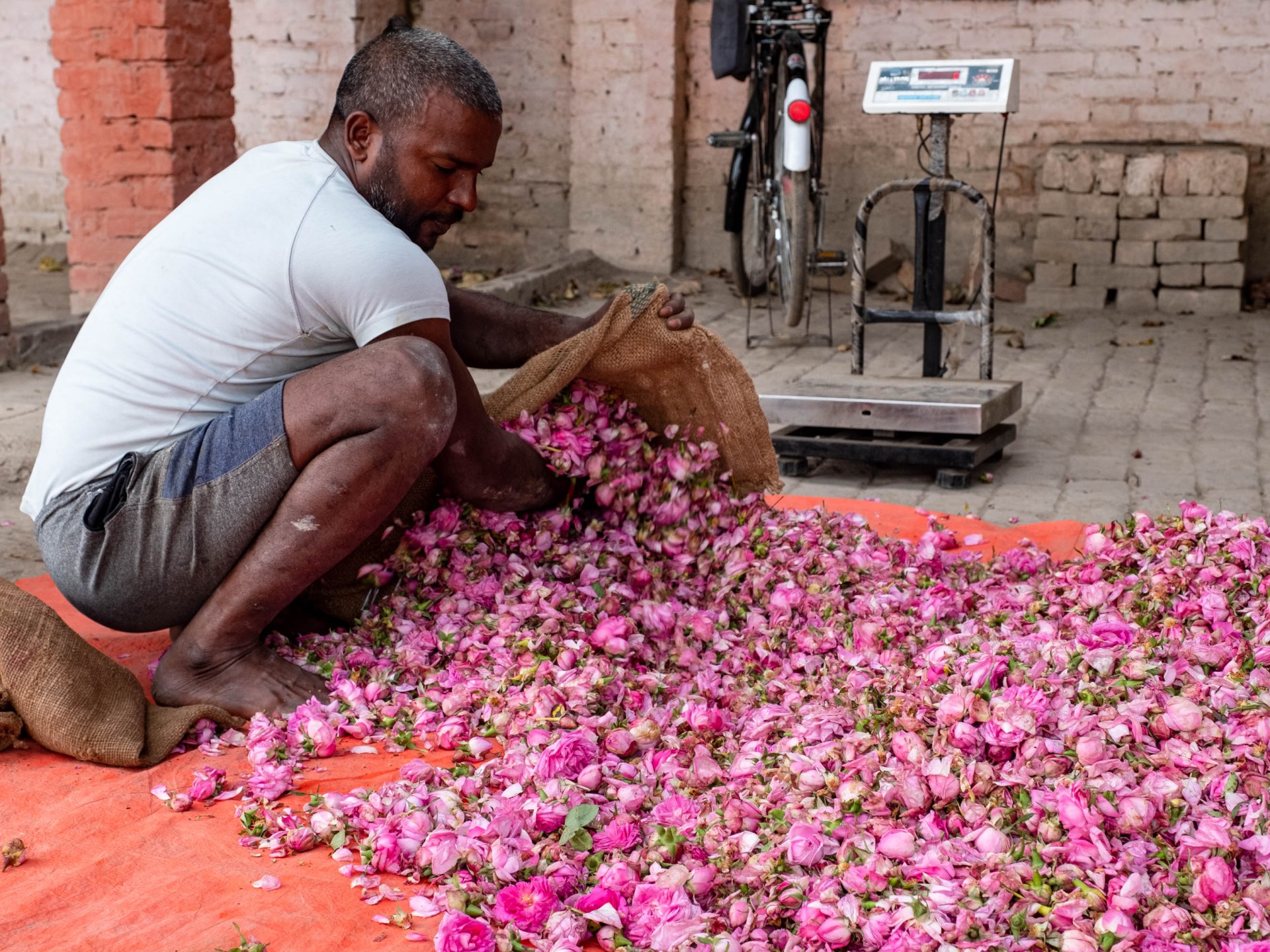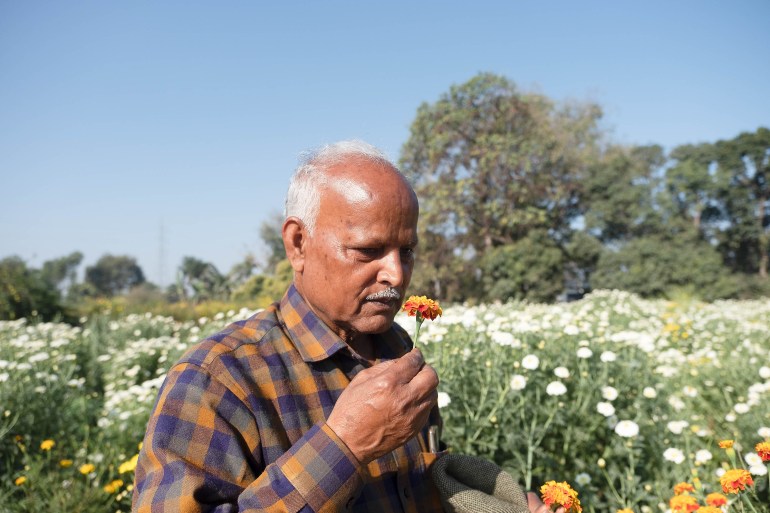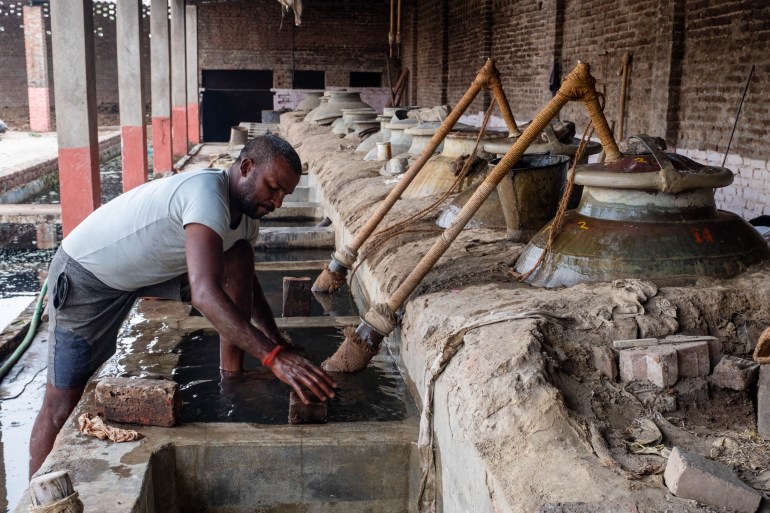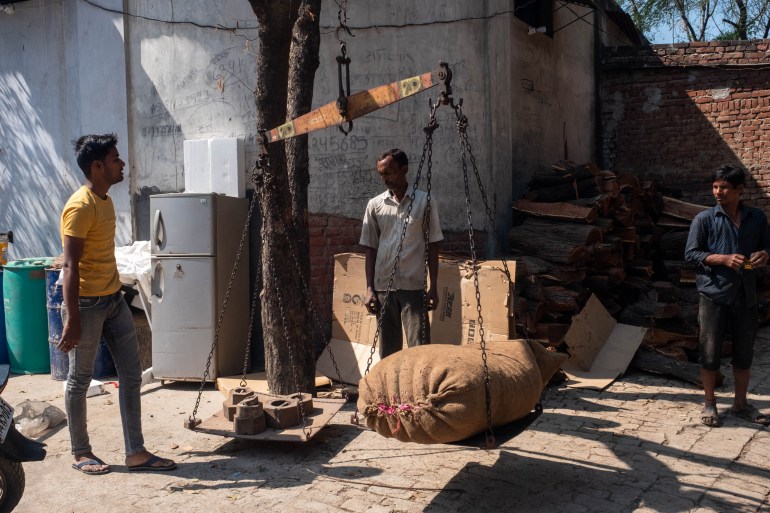
Smell that: The rise of India’s ittar industry | Business and Economy
- Politics
- December 17, 2023
- No Comment
- 383
Kannauj, India — Gopal Kumar pulled apart the bulb of a flower and pointed to where the roots of the petals had turned a little black inside. This is when the marigolds smell the best and are ready for picking, he said. He picked a pink rose next and sniffed. “You can only find this smell in Kannauj,” he said.
Kumar has been growing flowers outside Kannauj – a sleepy town nestled on the fertile plains of the Ganges in northern India – for 50 years. His flowers are used in the making of ittars, natural perfumes produced by distilling flowers, herbs, plants or spices over a base oil, which takes on the scent of the raw material.
Once a sophisticated kingdom in northern India, Kannauj is famed for its production of ittars using an ancient method called deg-bhakpa. This is a slow, laborious process of hydrodistillation devoid of all modern equipment that has survived in hundreds of small-scale distilleries across Kannauj and in surrounding cities.
Despite a long heritage of fragrance and scent, economic liberalisation of the late 1980s led to a period of decline in India’s ittar industry as cheap, alcohol-based perfumes were introduced from the West. Until the 1990s, there were 700 distilleries in Kannauj, but their numbers dropped to 150 to 200 by the mid-2000s. Trying to compete on price, some manufacturers started using alcohol as the base rather than more expensive sandalwood oil, degrading the quality and purity of the products.
Post-liberalisation, rather than selling directly to consumers, the vast majority of ittars and essential oils produced in India were exported to other businesses – either as an input into perfumery and cosmetic industries in the West or to the tobacco industry. Rosewater is an ingredient in chewing tobacco.
But in the past few years, several young, predominantly female Indian entrepreneurs have spotted a gap in the market between these indigenous artisanal skills and India’s thriving consumer culture, and a new set of homegrown brands has emerged.
A new wave of fragrance
Boond Fragrances is one such company, established in May 2021 during the pandemic by a sister and brother, Krati and Varun Tandon, to help preserve and raise awareness of the perfume-making traditions of Kannuaj and to support local artisans.
“Our father was a perfume trader and at-home perfumer,” Krati Tandon explained at her family home in Kannuaj. ”We grew up around perfumers and perfumeries in Kannauj, and you really absorb what’s happening. But we also saw over the years how some perfumeries started shutting down, and some are worried about their futures.”
The duo wanted to make ittars accessible. “The idea was really for us to bring it to customers – people like us who, if we knew something like this existed, would appreciate it,” Krati said.
Divrina Dhingra, author of The Perfume Project: Journeys Through Indian Fragrance, agrees. “Ittars have a marketing problem actually. In many ways they are stuck in the past,” she said. “But it is also an awareness problem. I don’t know if many people know this industry still exists, the way in which it exists, what it does, what is actually available.”

The initial response to Boond, Krati said, has been overwhelming with more than 10,000 orders dispatched in the 12 months up to October, a sizeable number for the young business.
Sales rise in winter, the Indian wedding season and the time when Christmas orders come from abroad. The company said it expects sales to double in the next two years but declined to share its revenue numbers.
“Recently, people have again started realising what synthetic perfume is and what real perfume is,” Krati said. “Particularly post-COVID, there has been a transformation back towards the real thing.”
As per market research firm Technavio, the Indian perfumery industry will increase by about 15 percent compounded annually for the next five years. While market trends are currently dominated by trade between businesses, the number of Indian firms selling their own fragrances directly to consumers is increasing.
Indian beauty writer Aparna Gupta said there’s been “a discernible shift, a renaissance if you will, in the domestic market’s attitude towards these traditional fragrances”, which are predominantly marketed on Instagram, and demand for them has gained “considerable momentum”.
She credited brands like Boond that are concentrating on traditional, time-tested ittar scents for playing “a pivotal role” in this resurgence. “They are not just selling ittars; they are reintroducing a forgotten art form to a generation that is eager to reconnect with its heritage,” she said.
Then there are other new brands like Kastoor and Naso Profumi that are targeting “younger consumers by blending traditional elements with modern nuances” – for instance, Kastoor’s Mahal with its unique blend of patchouli and lotus, Gupta said.
A tradition of scent

It is unclear exactly how long ittars and essential oils – made when vapours of ingredients are extracted but no base oil is used – have been produced through hydrodistillation in India. However, recently distillation stills excavated from the cities of the Indus Valley indicate a culture of scent in some form dating back to about 3,000 BC.
Around Kannuaj, many locals attribute the discovery of ittars to the Mughal queen Nur Jahan, who lived in the 16th and 17th centuries CE. However, Sanskrit texts indicate that the area was already a centre of fragrance before Mughal times. Historians believe the practice was invigorated with new ingredients and distillation methods further developed by the Mughal court.
Production is highly seasonal, and February in Kannuaj is the season of Damask rose. The warming winter sun was high in the sky by the time a motorbike arrived at the distillery of Prem and Company, a jute sack tied to its rear. Dinesh, the distiller, immediately weighed, inspected and emptied the dusky pink flowers into water inside a large copper vat called a deg.
Within minutes, the rim of the deg has been sealed with a metal lid and an airtight layer of water and clay, and a bamboo pipe has been connected from the deg to a second, smaller vessel, the bhakpa, which sits in a concrete sink of water.
Each deg is fixed over a furnace fired with wood or dung, and the distilled vapours pass through the pipes, collecting and condensing in the bhakpa. This bhakpa holds the base oil, which over time is imbued with the scent of the distilled material.
Boond Fragrances use local artisans, such as Dinesh, to distil both new scents and more traditional favourites, including Mitti, the smell of fresh rain, and Khus, known for its cooling notes. Just a dab suffices with 6ml (0.2oz) selling for $20.

The modern ittar
Kastoor’s founder, Esha Tiwari, wants to change existing perceptions. “Ittars are considered heavy,” she said. “In the earlier times, the ittars were so distinct. They were used by kings and queens as a mode of announcement. But I don’t want to drag you to the 14th century. I will bring this art form to your 21st century.”
Kastoor was set up in 2021. During research and development, 30-year-old Tiwari, who has a background in marketing, ran workshops to facilitate knowledge exchange between ittar artisans and modern perfume experts. The result was a set of seven “modern ittars”, in which trusted ingredients are combined in new, unique proportions with 8ml (0.3oz) selling for $22 to $36. The target market is middle-class, urban consumers looking for a completely natural perfume.
Growth has been rapid. Kastoor has another collection of ittars in the pipeline, and the number of artisans it employs has increased from three initially to 12 to 15 families across Kannauj, Hyderabad and Uttarakhand.
Tiwari found the younger generations of artisanal families were leaving the industry due to lack of prospects. “They didn’t see the demand,” Tiwari said. “That is where we came in. This is not a one-time hike we are giving to their business. It is a constant change in their livelihoods.”
According to Tiwari, Kastoor’s turnover is expected to rise from $120,000 and increase by 5 to 6 times over the next two to three years.
Made in India

In addition to the domestic market, these new brands are also exporting across the globe – to Europe, the United States, Japan, Australia and the Middle East. The absence of alcohol makes ittars non-haram and suitable for the religious purposes of both Hindus and Muslims.
The growing interest in sustainability and organic products worldwide is also bringing these producers new clients.
“In the beauty industry, there has been this entire movement towards natural and what’s local, and so in that sense, ittars fit in really nicely,” Dhingra said.
International perfumer Yosh Han said that globally, there is an “increasing desire to decolonise scent” and an “interest in POC [people of colour] brands” because of which some of these new Indian firms are getting interest from abroad.
Back in Kannauj, generations of knowledge and experience mean the local artisans are perfectly positioned to exploit and adjust to these new trends while promoting Indian products.
The name Kastoor comes from the word kasturi, which is also known as musk, a scent of a deer’s navel. According to folklore, the deer was enchanted by this scent and searched for it, not understanding that it was coming from itself, Tiwari explained.
“So we have used it as a metaphor,” she smiled. “We are still frantically looking outside, not realising that we are the creators of the world’s most magnanimous scents.”
#Smell #rise #Indias #ittar #industry #Business #Economy









